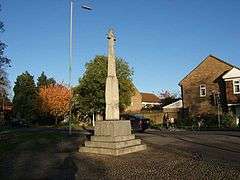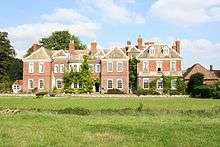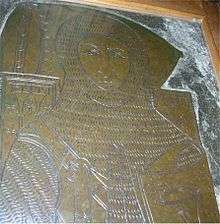Trumpington
| Trumpington | |
 War memorial, Trumpington |
|
 Trumpington |
|
| Population | 8,034 (2011. Ward)[1] |
|---|---|
| OS grid reference | TL442549 |
| District | Cambridge |
| Shire county | Cambridgeshire |
| Region | East |
| Country | England |
| Sovereign state | United Kingdom |
| Post town | CAMBRIDGE |
| Postcode district | CB2 |
| Dialling code | 01223 |
| Police | Cambridgeshire |
| Fire | Cambridgeshire |
| Ambulance | East of England |
| EU Parliament | East of England |
| UK Parliament | Cambridge |
|
|
Coordinates: 52°10′26″N 0°06′32″E / 52.174°N 0.109°E
Trumpington is a village on the outskirts of Cambridge, England. It is located on the southwest side of the city and borders Cherry Hinton to the east, Grantchester to the west and Great Shelford and Little Shelford to the south-east.
The village was a separate parish from Anglo-Saxon times until the twentieth century. In 1912 all of the land north of Long Road was transferred to Cambridge, and in 1934 the majority of the remaining land, including all of the village, was also given over to Cambridge. Only 382 acres, almost uninhabited, were transferred to Haslingfield parish.[2] The present Trumpington ward of Cambridge City Council also incorporates the Newtown area of the city, north of the historic parish boundary.
History
There is evidence of Iron Age and Roman settlements in Trumpington, near the River Cam ford by the road to Grantchester, and a Roman cemetery. An Anglo-Saxon cemetery has also been found nearby at Dam Hill.[2]
By 1086 there was a thriving community of 33 peasants at the time of the Domesday Book, and the population had risen to 100 by the late 13th century. The village remained sizeable throughout the Middle Ages and by 1801 there were 494 residents. By the time the parish was dissolved there were around 1200 inhabitants.[2] Until the 20th century Trumpington was an agricultural village with cattle and sheep as well as crops. [3]

Trumpington's association with agriculture was extended further in 1955, when the Plant Breeding Institute (PBI) – founded in 1912 as part of the University of Cambridge's School of Agriculture – moved to the Anstey Hall site adjoining Maris Lane in Trumpington. Here the PBI developed new plants, notably potatoes called Maris Piper and Maris Peer, a barley called Maris Otter, and a wheat called Maris Widgeon. These are now in use worldwide. In 1990 the PBI relocated to Colney, near Norwich, but the reference to the Maris Lane site survives in the names of plants.

Anstey Hall is a former country house built c.1700 within its own parkland. Once owned by writer and poet Christopher Anstey and later by the polymath Robert Leslie Ellis, it was leased to the PBI for many years. It is now used for weddings, parties, corporate events and meetings.
The Trumpington War Memorial was designed and carved by Eric Gill, who also designed and carved the crocodile [4] on the wall of the Cavendish Laboratory. The memorial was dedicated on Sunday 11 December 1921 to commemorate 36 Trumpington men who died in the First World War. The Second World War claimed eight more local men; their names were added by David Kindersley, a pupil of Gill.
Trumpington Fair
In 1314, the lord of the manor, Giles of Trumpington, was given permission to hold a three-day fair on the feast of St Peter's Chains (August 1). The feast was still held in the 19th century though was transferred to June 28-30, and became known for the rowdiness and drunkenness of its many visitors. It was reduced to only one day (June 29) in 1882 and was still held in the 1930s.[2]
Church

There was a church in the village by the start of the 13th century. Parts of the present church, dedicated to St Mary and St Michael, date from the mid-13th century and the nave was rebuilt in the 14th century.[2]
The parish church is the resting place of Henry Fawcett, the blind academic and politician who, as Postmaster General (1880-1884), introduced parcel post, postal orders and other innovations. The primary school is named Fawcett School after him. The church also contains the monumental brass of Sir Roger de Trumpington, a crusader knight bearing the date 1289; it is said to be the second oldest brass in England.[5]
"Southern Fringe" developments
Cambridge City Council's 2006 Local Plan provided for the release of an extensive area of Green Belt land around Trumpington for new housing and associated community facilities. Major new developments are being constructed on the Glebe Farm and Clay Farm sites to the south and east of the village, and on Trumpington Meadows to the south-west.
Trumpington bed burial
In 2012 archaeologists working on the Trumpington Meadows site discovered a 7th-century Anglo-Saxon bed burial for a young woman aged about 16 years old, in a field on the outskirts of the village. The occupant of the grave had been buried on a wooden bed, and had an ornate gold pectoral cross inlaid with garnets on her breast. The jewelled gold cross is very unusual, and can only have belonged to a member of a rich aristocratic family. It is thought that the grave must have been associated with a hitherto unknown Anglo-Saxon settlement near the site, perhaps that of a monastic community.[6]
Cultural references
- Chaucer's The Reeve's Tale is set in the village, and a water mill on the River Cam is mentioned in it. The location of the mill is believed to be Old Mill Holt on the river to the southwest of the village.[2]
- The nineteenth-century novelist G. A. Henty, was born in Trumpington.
- The BBC journalist Bridget Kendall grew up in Trumpington and attended Perse School for Girls.
- Pink Floyd's lead singer and guitarist, David Gilmour, lived in Trumpington in his early childhood.
- In the "Matthew Bartholomew" series of novels by Susanna Gregory, Trumpington is the location of the Manor House belonging to Matthew's sister and husband.
- Trumpington residents is referred to in Rupert Brooke 's poem "The Old Vicarage, Grantchester", written in 1912 - "...they fling oaths at one, / And worse than oaths at Trumpington."
References
- ↑ "Cambridge Ward population 2011". Neighbourhood Statistics. Office for National Statistics. Retrieved 25 July 2016.
- 1 2 3 4 5 6 A. P. M. Wright (1982). A History of the County of Cambridge and the Isle of Ely: Volume 8. Victoria County History. pp. 248–267.
- ↑ Trumpington Residents’ Association
- ↑ Department of Physics, Cavendish Laboratory, 100 Years and more
- ↑ Genealogy UK and Ireland: Trumpington
- ↑ Kennedy, Maev (16 March 2012). "Cross and bed found in Anglo-Saxon grave shed new light on 'dark ages'". The Guardian.